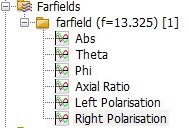[reflectarray antenna]---> cross polarization simulation using HFSS or CST
I am still simulating a reflectarray using ring elements. For now I already got the pattern simulation results for the whole reflectarray. I am using rectangular waveguide as the excitation, instead of using feed horn, to simplify the structure.
Now my problem is: how can I simulate the cross-pol level for reflectarray? For example, assuming that the rectangular waveguide is transmitting H-pol EM wave, how can I detect the energy reflected from V-pol in HFSS or CST? I know in chamber I can just put two H, V horns there, one TX and one Rx. But in simulation I dont know how to do this... I searched some posts, one solution is to use microstrip hybrid coupler, which has 4 ports and could give H and V pol.
One more thing, the element is circular ring. So I think the cross-pol level could be defined by both the following:
1. transmit H, receive V for linear pol
2. transmit RHCP, receive LHCP for circular pol
Is that right?
thanks so much
panou
You can do this easily in HFSS through the Reporter. Just plot RHCP Gain and then plot LHCP gain, one will be co and one will be cross pol to to a CP antenna. Likewise, you can compare the gain x gain y or gain phi and gain theta. You can also look at the axial ratio...
have fun
Thanks, Tallface!
I used CST for the array simulation, in the [farfields] results, it gives like following:

I polted all the abs, theta, phi, left, right data. The gain theta vs gain phi has a x-pol about -50 dB at broadside, but the RHCP gain is toally the same with the LHCP gain. I think the reason is that I am using a rectangular waveguide as the feed, so the CP is not excited. The ploted axial ratio is very high, like 40 dB in broadside, this could also prove it is a linear pol, right?
Really appreciate for your help.
Can you post a simple simulation to this page with your results? Thanks.
You can easily calculate cross-polarization in HFSS or CST.
There comes the fancy part: Cross-polarization definition.
If you are checking the cross-polarization level on the principal planes (E or H-plane) then there is no confusion.
The important thing, if your array or your antennas have symmetry planes you won't get anything on the principal planes (E-plane or H-plane) only the numerical error. Typically diagonal planes have the worse cross-polarization performance, and therefore they are checked and plotted for many applications.
However, if you are checking points other than principal planes, then you have to pick a "Cross-polarization definition". You have to pick one of three Ludwig definitions.
You can find it at:
Ludwig, A.; , "The definition of cross polarization," Antennas and Propagation, IEEE Transactions on , vol.21, no.1, pp. 116- 119, Jan 1973
doi: 10.1109/TAP.1973.1140406
URL: IEEE Xplore - Sign In
Note that all three reduce to same vectors in principal planes.
Hope this helps. Both CST and HFSS can calculate cross polarization using all three Ludwig cross-polarization definitions. The most commonly used one is Ludwig's 3rd definition as most measurement facilities measure the cross-polarization in a way that is compatible for this definition.
Edit: I figured that this was an old post. But, I think the stuff posted here can be useful for others as well...
Thanks Chameleon!
Mark this~
Hello,
Can u tell me the steps how to find the co and cross polarisation plots for the patch antenna using HFSS and CST.
Thanx in advance.
Hi,
1) Create (in solve menu) Farfield Monitor(s) @ n frequency
2) Simulation
3) The results will are in the farfield directory -> choose the good representation (ludwig 3 linear or circular) by click right : properties, axis tab...
BR
- - - Updated - - -
Hi panou,
Do you use the Floquet's modes of CST ? to analyze your reflect array...
Tell me...
BR
Hello,
i want to know, how boresight direction is defined for a cpw fed patch antenna, also in which direction do we usually measure x-pol and AR (e-plane max, h-plane max or boresight)
thanks
hi, Im using the hfssv11 but im nt getting the results can u tell me am i right
steps by me result> far field report > radiation pattern > gain
in category gainX is copolarization & Y means Cross polarizatin
am i right ?
